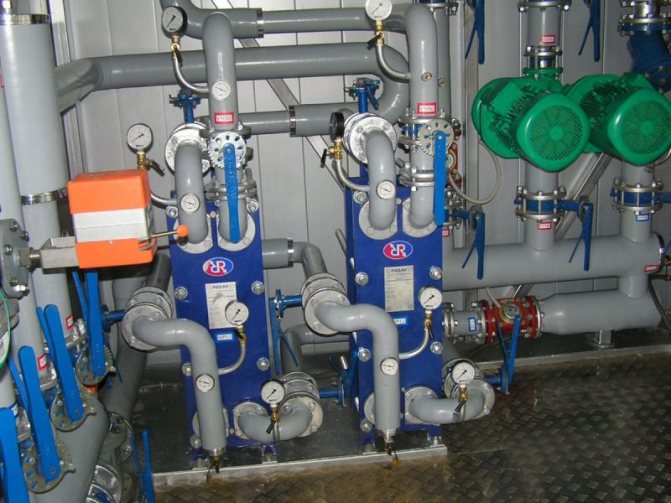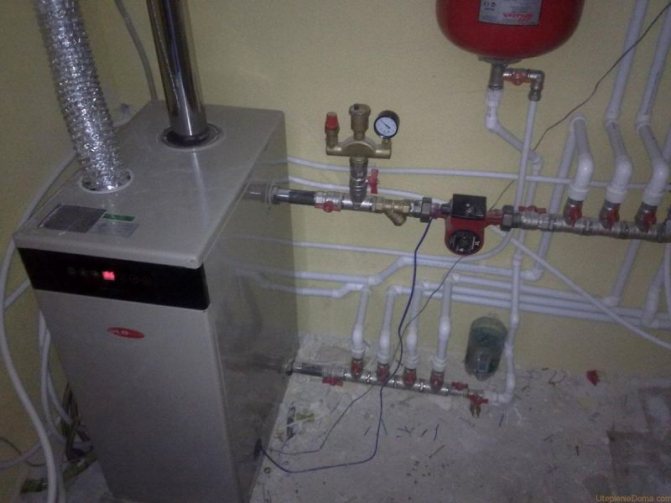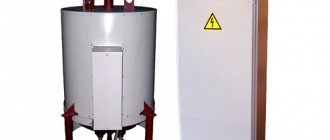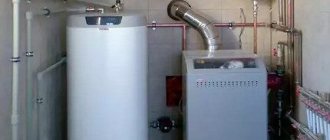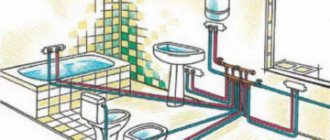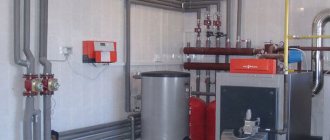Installation of autonomous heating in an apartment: difficulties
As mentioned above, in the case of a private house, everything is much simpler. Here you can install both a gas and an electric boiler, as well as a liquid fuel and solid fuel. In a private house, no one forbids making a water floor or installing solar panels on the roof, a solar heating collector or installing a heat pump in the house. Or you can even build a mini-boiler room next to a residential building.
But in the apartment, most of the described options are forbidden to do, because:
- not every project from a practical or technical point of view is possible in a building with many tenants and in a limited area;
- it can harm the interests of neighbors;
- there are legal restrictions on such projects.
So, in an apartment it is simply not practical to install a solid fuel boiler, since there is no necessary room, and just a place to store fuel - firewood or coal. But the floors of buildings are usually not designed for such a significant additional load. As well as storing large amounts of combustible material in a living space, it is dangerous.
It is not allowed to install a warm water floor in the apartments of apartment buildings, only its electric version is allowed. However, first of all, when switching to autonomous heating in an apartment building, one has to face legal difficulties. Thus, in some regions, refusal from central heating is generally prohibited by local regulations.
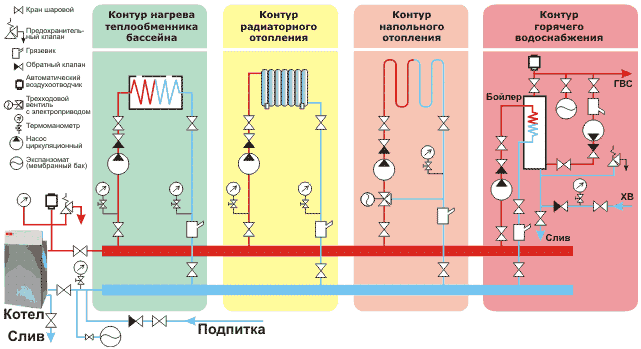
Autonomous heating system diagram
That is why it is necessary to start not with project documentation, but with a consultation with a lawyer. After all, it is possible that in order to make autonomous heating in an apartment building, permission will have to be obtained through the courts. In this case, such a permit is needed both for refusal of centralized heating, and for the installation of autonomous heating.
Water heating
Autonomous gas heating in a private house always provides for the presence of pipes with water. Further, they can either lead to radiators on the walls, or be taken away under the floor covering, thereby providing a warm floor.


In some cases, these two systems are used together to achieve greater comfort, because people like the presence of a warm floor, and you will not argue with that if you try it yourself.
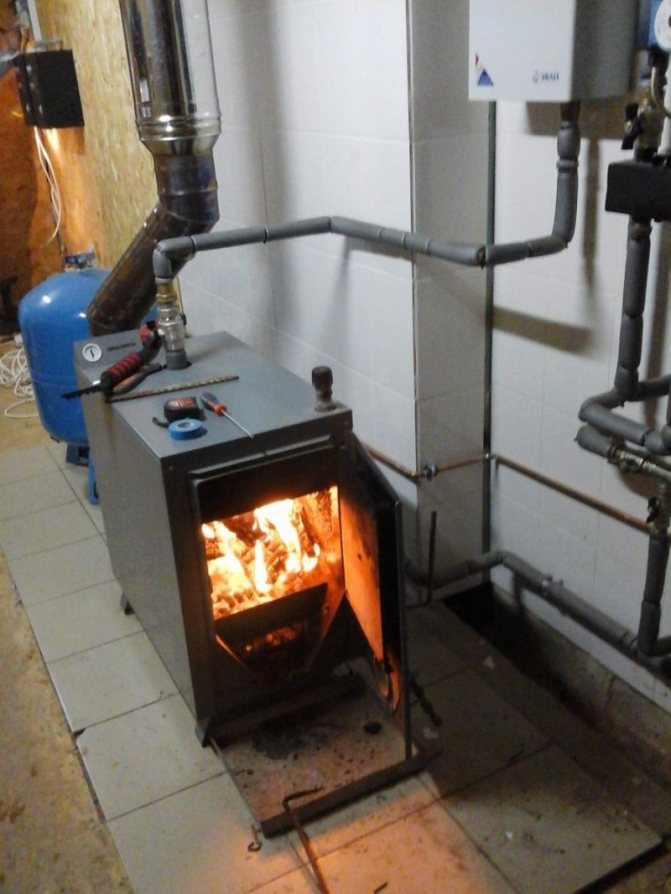

How can you provide heat supply for apartment buildings
There are two options - to power the heat pipelines from the main heating networks or to install an autonomous heating point.


Modern technologies make it possible to provide autonomous heating for a house with many apartments.
Both options are good, but the presence of an individual heating point for several apartment buildings and autonomous heating with the use of energy-saving means will please more. Why?
Because the distance between the “heat point - consumer” pair is minimized, thereby reducing heat losses through the heating network. This type of heating is called decentralized, or autonomous.
Pros:
A lower percentage of costs for heating and hot water supply in an apartment building - and all because the costs of transporting and delivering the heat carrier to the end consumer are reduced.
Simply put, the source of heat supply is practically nearby, and therefore, both the time for supplying heat to residential buildings and the percentage of heat losses are reduced. This also results in a reduction in the cost of maintaining, servicing and repairing heating networks.
The efficiency of heat supply systems - as a consequence, follows from the previous factor. Since the source of heat supply is nearby, the amount of payment for utility services for hot water supply and heating is somewhat lower.
Independence from the citywide heating schedule. In other words, while heating has not yet been provided in the city (“because the heating season has not started according to the schedule”), and the temperature outside is already low, apartment heat supply from an autonomous heat source will come in handy.
In addition, each consumer will be able to choose the optimal temperature conditions for his apartment - turn off / turn on the heating system only for his apartment, adjusting the level of heat supply.
Lower cost and higher return on investment for new buildings with an autonomous heat supply source.
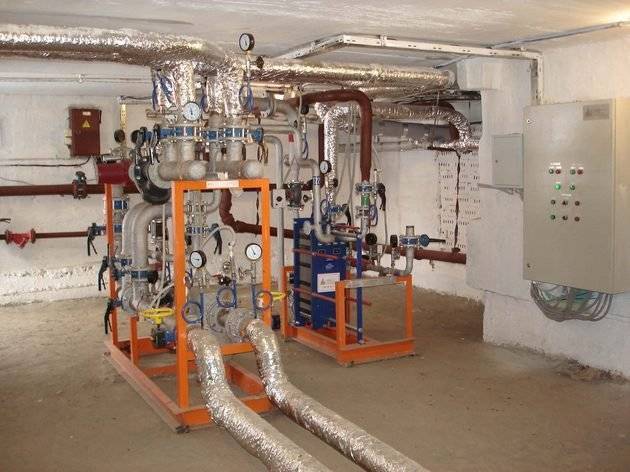

A separate boiler room in each house will increase the free space in the yard. Click to enlarge.
The presence of "additional free space" within the whole microdistrict. This also contributes to the implementation of housing programs, the construction of new buildings and the arrangement of microdistricts not for heating mains, but for the infrastructure of the districts.
In addition, the provision of apartment buildings with an autonomous source of heat supply is possible even if there is already an established gas supply system in the construction area.
disadvantages
However, along with the advantages that consumers of decentralized heating and hot water supply have, there are a number of disadvantages:
- The need for additional space allocated for the construction of an autonomous boiler room.
- Non-environmentally friendly work of the boiler room. For a gas boiler house operating autonomously, it will be necessary to additionally equip an exhaust gas discharge system in order to reduce smoke emissions into the atmosphere as much as possible, having received the MPC (maximum permissible concentration) value required by SNiP.
- Cost. Since autonomous heating today is not yet as popular and in demand as centralized heating systems, the production of boiler equipment for it has not been put on the "conveyor" either. Consequently, prices for decentralized heating and hot water supply systems are still high.
Is it possible to eliminate the above disadvantages completely, or at least reduce them to a minimum? Can. Additional area for an autonomous boiler room can be "found" on the roof of a multi-storey building, which will be heated.
An increasing number of newly built houses are already equipped with a roof boiler room with equipment installed at the top and upper piping.
Of course, the installation of additional equipment will cost, and the decentralized heat supply of one apartment building itself is not cheap, but it will all pay off faster than if the house was simply connected to a centralized heating system.
Pipes: what are there, how to choose
For the autonomous system to work properly, the pipes must withstand pressure up to 2 atmospheres and liquid temperatures up to 95 degrees. Should serve for decades, ensure tightness. For external pipes, it is still nice to have a decent look.
It is possible to increase the thermal energy in the pipe by taking pipes with a large diameter, or to accelerate the movement of the fluid. It should be remembered that excessively fast fluid movement creates hydraulic noise. This is extremely uncomfortable for life. Therefore, the movement must not be accelerated more than 1.5 m / s. And knowledgeable plumbers do not advise at all to exceed the 1 m / s mark. Making it lower than 0.25 m / s is also not desirable - there will not be enough power to push through air jams.
In older houses, a steel pipe system was often used in combination with cast iron radiators. This technology is outdated. New materials guarantee new characteristics. What are the best pipe materials?
- Metal-plastic - the base is made of aluminum composition, the shell is made of polyethylene. They are used in hot and cold water supply.Pros: tightness, good flow capacity, tear resistance.
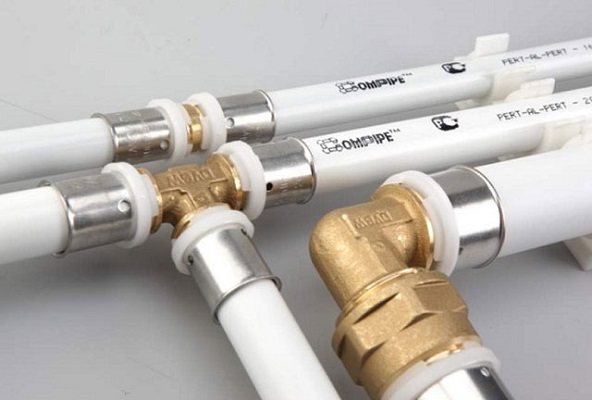

Reinforced-plastic pipes
- Copper pipes - used for 3 centuries and this material has proven itself well. Copper pipes are durable and resistant, do not deteriorate for decades. For the shell, a layer of polyethylene or polyvinyl chloride is sometimes made outside.


Copper pipes
- Steel pipes - in the absence of an alternative, the most demanded. They are durable, have a low coefficient of expansion, and are indispensable in heat supply and steam heating. Cons: The material is corrosive.
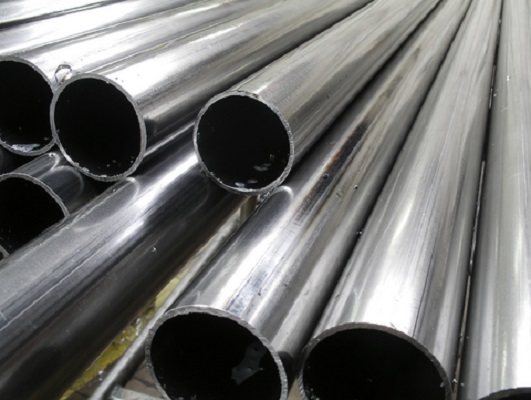

Steel pipes
- Stainless steel pipes - made of alloy steel. Due to their durability and resistance to corrosion, they pay off in several years, although they are not cheap. Often, it is not necessary to repair the pipeline and change its individual parts.


Stainless steel pipes
- Polypropylene pipes (PP or PPR) - switched from water supply to heat supply. PP pipes will last from 30 to 50 years. They do not corrode. They are not afraid of aggressive components in the composition of the coolant.


Polypropylene pipes
The pipeline works smoothly if:
- Consider the heating system diagram before purchasing pipes;
- Calculate 4 parameters: required pipe diameter, heating system power, coolant speed, hydraulic calculation;
- Take only from trusted manufacturers.
Varieties of decentralized heat supply
Another example of autonomous heating of a multi-storey residential building can be a block boiler room, consisting of a separate module. Block or modular boiler rooms can be transported as they are delivered in the form of containers.
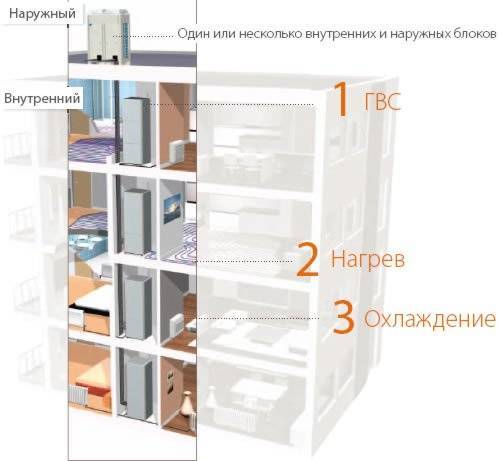

The use of modular boiler rooms in an apartment building. Click to enlarge.
Their implementation does not require the construction of a new building specifically for the boiler equipment - the entire installation is already "enclosed" in a container, moreover, the module is thermally insulated, and the assembly is carried out directly at the manufacturing plant.
Previously, such blocks were used as heating systems for temporary structures (change houses), but now they are offered (after a number of modifications) as an alternative to centralized heating.
But the best option for autonomous heating is an apartment heating system powered by a main gas pipeline or through a power supply network (depending on the type of boiler), the "core" of which is a wall-mounted boiler (gas or electric).
Why wall-mounted? Because wall-hung boilers have a number of advantages:
- Convenient in installation, easily hung on the wall using a set of fasteners (fasteners must be supplied with the boiler equipment)
- They are lightweight and small in size, do not take up much space in the room
- With their size, they have good power (10-25 kW) and are able to heat a room up to 100 m2 - and this is quite enough for one four-room apartment
- Manufactured as one- and two-circuit
If the owner of the apartment plans to install a wall-mounted gas boiler as heating equipment, then he should check the completeness of the equipment, namely:
- Boiler with two circuits (operating for both space heating and hot water supply)
- Combustion chamber - closed type
- The presence of a fan to provide forced draft (intake of fresh air from the street) and the removal of combustion products through the chimney
- Pump for forced circulation of the coolant
- Electronic ignition and full automation - for rational use of fuel
In the case of an electric boiler, which also works according to a two-circuit scheme (heating + providing the consumer with hot water), there will be much less difficulties: it will be necessary to obtain permission only for the allocation of an additional power line, plus agree on the insertion of direct and return pipes into the common water supply system.
The only exception will be electrode boilers without heating elements, which work to heat running water.
Boiler equipment: what are the selection criteria
Boilers are classified according to six criteria:
By type of fuel
- Liquid fuel boilers are reliable, they heat up a large house, they are endowed with automation. They have many disadvantages: expensive fuel, they are obliged to carry out preventive maintenance according to the schedule, which are not environmentally friendly. The main parts of such boilers are: oil burner, heat exchanger, automatic control, fuel storage tank, chimney.
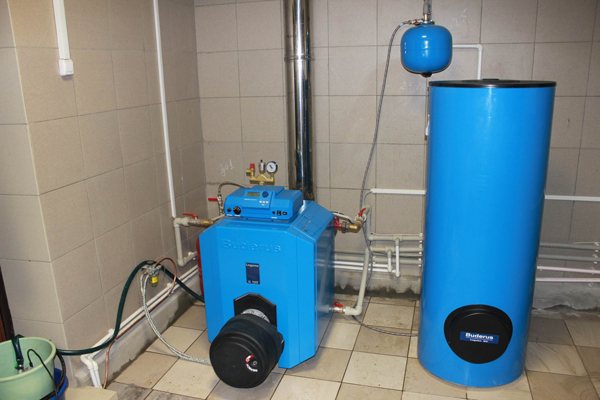

Diesel boilers
- Electric boilers are affordable and reliable equipment. No need to make a hood and chimney. It doesn't take long to look after. They save space in the house. Cons: expensive, electricity dependent. Most often, TEN boilers are produced. They have tubular heaters inside, plus a control and monitoring unit. The working pressure is created by a circulation pump. The main plus is that the coolant does not come into contact with electricity, which means that the boilers are safe.
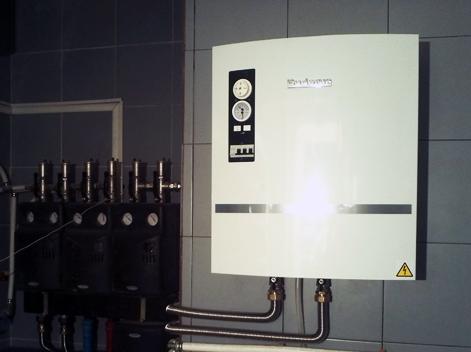

Electric boiler
- Solid fuel boilers. Fuel is wood, coal, coke, pellets (wood pellets). They do not depend on electricity and are inexpensive. They are pyrolysis and pellet.
Solid fuel boiler
- Gas boilers are the most popular if the house is connected to the gas main. This is a cheap fuel, and there are almost no drawbacks. If gas is needed and you are not connected yet, then a lot of time and money will have to be spent on gasification. The main components of gas boilers are: burner, fittings, heat exchanger.
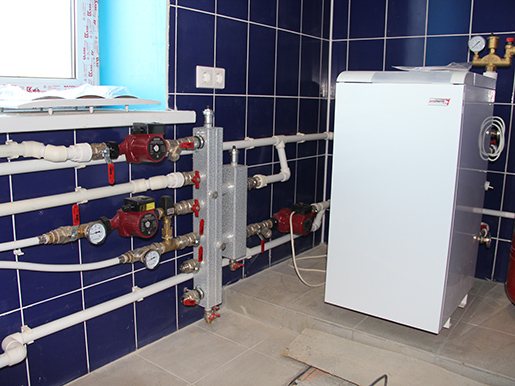

Gas boiler
- Combined boilers - work on two types of fuel. When one is not there, you use the other. Thus, you prevent malfunctions in heating. However, any universal equipment has disadvantages: it is difficult to install, troublesome to repair, and is inferior in reliability. There are models that run on four types of fuel. To switch to another type of resource, sometimes two stages of burners are made. All station wagons are floor-standing and made of cast iron. The boiler can be automatically controlled and monitored. The cameras inside are located one above the other.
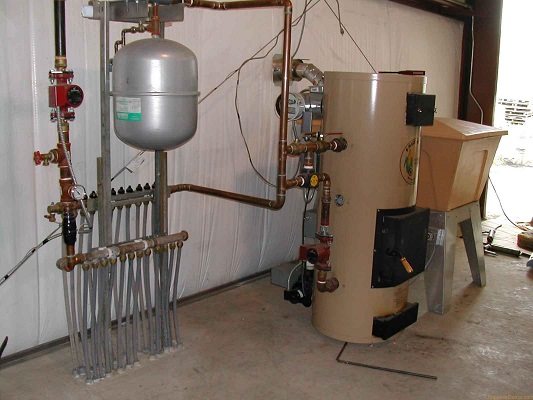

Combined boiler
Costs for heating a house with an area of 300 m² by type of fuel:
| Options | Electricity | Diesel | Gas |
| Fuel consumption per year, kW * h | 80000 | 80000 | 80000 |
| Heat energy, kW / l | — | 11.6 (37.7 mJ / kg) | 7.2 (46.3 mJ / kg) |
| Cost, rub / kW * h | 2,66 | 2,15 | 1,53 |
| Costs per year, rub. | 212800 | 172000 | 122400 |
Boilers by design
- There are single-circuit and double-circuit. Single-circuit boilers work as part of the heating system. They are connected, and the coolant only heats the house. Such a boiler does not serve household needs; the hot water supply system will have to be thought out additionally.
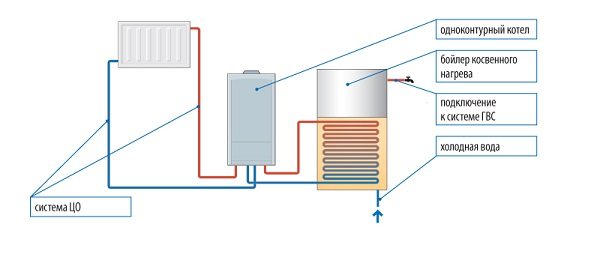

Single-circuit boiler
- A double-circuit boiler both heats the house and provides hot water. You can wash the floor and dishes, take a bath, wash. The boiler heats up the water through a heat exchanger.


Double-circuit boiler
Boilers by accommodation
- The boiler room is located separately - this is done if the house is large and you need powerful heating equipment. It is placed outside the home. Such a structure is insulated and trimmed with non-combustible materials. It is expensive and difficult to design, but safe.
- Boiler room in the annex next to the house - suitable when the unit is noisy, and it is impossible to mount it in the house. The extension is made of fireproof materials. This also requires significant costs. For these two types of placement, a boiler with a capacity of no more than 500 kW is suitable.
Requirements:
- the extension is made from a blank wall. The distance to the nearest window or door should be at least 4 meters;
- with a separate location of the boiler room: the extension should not be connected to the house by a common wall; the minimum distance from windows to overlap is 8 meters;
- the volume of the room is more than 15 m, take care of free access in the process of servicing the boiler and equipment;
- the minimum ceiling height is 2.5m2;
- the minimum total volume of the room is 15 m3, and for each additional kilowatt of boiler power, add 0.2 m3 of the room volume;
- to separate the room from adjacent walls with a refractory layer (with a zero limit of fire propagation and fire resistance of 0.75 hours);
- the square of the glazing must correspond to: 00.3 m2 for each cubic meter of the room;
- the minimum volume of the hood should be equal to three times the air exchange of this room per hour;
- Boiler room in a separate room of the house. For this, a room is allocated, they also think over fire safety. Convenient to monitor and maintain. But it takes up a lot of space. For such an arrangement, you can take a boiler with a capacity of no more than 150 kW.
Requirements:
- the minimum ceiling height is 2.5 m or more;
- the volume of the room is more than 15 m3, take care of free access in the process of servicing the boiler and equipment;
- to separate the room from adjacent walls with a refractory layer (with a zero limit of fire propagation and fire resistance of 0.75 hours);
- the square of the glazing must correspond to: 00.3 m2 for each cubic meter of the room;
- the minimum volume of the hood should be equal to three times the air exchange of this room per hour;
- Built-in boiler room - if there is no separate room. This option is the most budgetary. The equipment is placed in the kitchen or hallway. You will have to choose compact devices, bulky equipment takes up a lot of space and creates an increased danger. The kitchen needs a boiler with a capacity of no more than 60 kW.
Requirements:
- the minimum ceiling height is 2.5 meters;
- the minimum total volume of the room is 15 m3; and add 0.2 m3 for each additional kilowatt of boiler power;
- the minimum volume of the hood should be equal to three times the air exchange of this room per hour;
- a window with a window is required;
- at the bottom of the door, a gap of 0.025 or more is needed for air exchange;
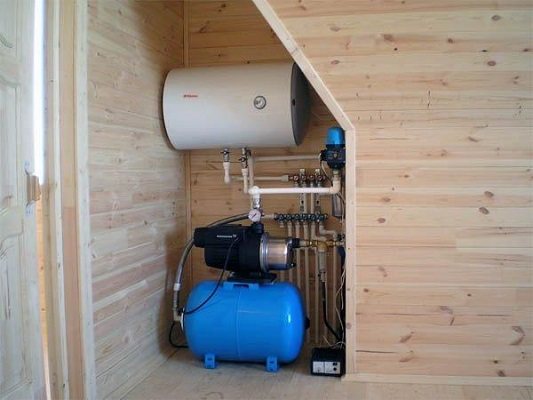

Built-in boiler room
Boilers by location
There are wall and floor ones. The first ones are hung on the wall. They save space in the house, are inexpensive, and there is no need to design a complex chimney. It is led out through a short pipe through the wall above the boiler. The disadvantage is low power: depending on the model, they operate in the range of up to 42 kW. Suitable for heating houses and apartments up to 350-400 m2.
Floor stands are chosen for houses up to 600 m2 of area. They work with power up to 80 kW. There are models with an indicator up to 375 kW. Due to the noise and large size, they require a separate room and sometimes soundproofing. A separate chimney will be required.
Boiler rooms by the way of circulation
The fluid inside the system can move naturally and forcibly. Natural movement occurs due to the balance of density and temperature. This option is suitable when the length of the pipeline is less than 30 meters. It is necessary to mount the system, observing the angles of inclination. Lack of an inclined highway in an unaesthetic appearance.
Forced circulation does not limit the length of the lines. Regardless of the placement of the pipes, the pressure remains high. You will also have to buy a circulation pump. It will also require additional electricity bills.
By the method of connecting the supply and discharge pipes
There are one-pipe and two-pipe schemes. With a single pipe, the coolant moves in stages through all radiators. It costs less, but works worse: the near radiators are hot, and the distant ones are cool. It is impossible to regulate the temperature if you do not use an improved version of the one-pipe system - Leningrad.
The two-pipe system is more expensive, but it works better: it distributes heat evenly over the batteries. The temperature in each room can be adjusted. It is divided into types depending on the location of the pipeline contour:
- The horizontal one is suitable for single-storey houses with a long pipeline;
- Vertical is used in houses with more than one floor.Due to the vertical riser, the system is less susceptible to airing. The bubbles rise to the top-mounted expansion tank and do not accumulate in the pipes.
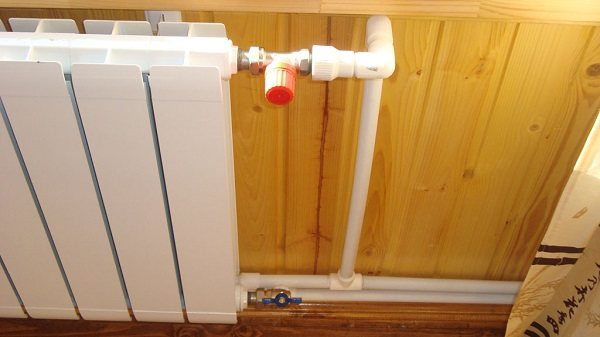

Two-pipe system
Autonomous heating in an apartment building
Is it possible to install autonomous heating in an apartment with your own hands? Although there is no legal ban on autonomous heating, it is still advisable to consult a lawyer, since some heating systems are prohibited. For example, water heated floors in apartments cannot be installed due to the fact that they can overload the system, thus depriving other residents of the house of heat.
In other cases, it is required to collect the necessary documents and submit them to local authorities:
- registration certificate for housing;
- a statement of abandonment of central heating;
- title deed;
- a diagram of a new heating system;
- the consent of all tenants of the apartment.
As a rule, such a seemingly simple request, such as giving up central heating and switching to heating itself, turns out to be a long-term bureaucratic problem.
Installation of autonomous heating in an apartment without the appropriate permission will become even more troublesome. This can end not only with a large fine, but also with legal proceedings, so before deciding to equip an apartment with any heating systems, you need to get advice from the relevant authorities and a permit for autonomous heating in the apartment.
Autonomous heating schemes for an apartment:
Advantages and disadvantages
If a permit has already been received for autonomous heating in an apartment building, then you can start choosing an alternative type of heat. It is easier to do this knowing the pros and cons of autonomous heating in the apartment.
For the first time, an autonomous heating system for an apartment appeared in Europe. Due to its clear advantages over centralized methods of space heating, it quickly spread throughout the world.
- The main advantage of the system is the significant cost savings. The owner of the apartment independently decides when to turn on and when to turn off the heating. For example, today there are thermostats in which you can set a timer for a specific time, which allows you to either completely or partially turn off the system when there is no one at home, and turn it on half an hour before the arrival of the tenants.
- The owner of the apartment can create the desired microclimate in each room.
- Pay exclusively for the heating meter and not depend on utilities and government tariffs.
When making a choice in favor of alternative heat, you need to know in advance how much autonomous heating costs in an apartment, and what kind of heating it will be not only economical, but also effective.
Among the disadvantages of such a system, the following nuances can be noted:
- Its regular preventive check once a year, for which you need to call a specialist. It's not that expensive, but still, many users either ignore this need, or simply forget about it.
- Installing even the best heating radiators for an apartment. you should be aware of possible heat loss. which are often caused by exterior walls, unheated from the bottom of the room or poor quality glazing.
Today, many construction organizations are building residential apartment buildings with ready-made autonomous heating systems. Such housing is in great demand, as it costs a little less and allows the owners to independently decide which type of heating to choose.
What does autonomous heating mean
As a rule, today either gas or electrical heating equipment is installed in apartments. In the first case, the most optimal option is a double-circuit gas boiler, since this way it will be possible not to pay in housing and communal services for warm water.As for electricity, it is usually not used directly to heat a room, but indirectly, for example, to power a heat pump.
However, whatever your choice turns out to be, you will always have to take into account the upcoming dismantling of the old heating system, and this is usually very difficult. However, it will most likely not be possible to save money - you can use the pipes of the old system for new heating only if they are in good condition, that is, the house is new, or the heating has been changed recently. All this suggests that you will hardly be able to install autonomous heating in an apartment with your own hands.
Here we need the help of qualified specialists with extensive experience in this area. And, in general, heating with your own hands is a rash risk, since, for example, only a professional with a special permit can install gas equipment and start it for the first time.
We recommend: How to make autonomous heating in a private house?
So, option number one is gas heating. For a city apartment, a modern double-circuit gas boiler is perfect, with electric ignition, a closed combustion chamber, a programmable thermostat and a built-in security group. It is this configuration that allows you to maintain the optimal temperature in the room at any time of the day. But you can also get a volumetric storage boiler - this will also allow you to save on hot water, and install a cheaper single-circuit boiler in the apartment.
Advantages and disadvantages
Since the automation for gas boilers is already made of high quality, then usually after starting and setting it up, you don't have to worry about its operation. The foreseen security system will eliminate the likelihood of gas leaks and minimize other possible risks - with proper operation, of course.
If the apartment is small, then you can pick up a completely compact boiler of lower power, which will not take up much space, but will work almost silently. Moreover, prices for sufficiently high-quality domestic equipment vary in a wide range. Foreign (European) gas equipment is much more expensive. But both will be enough for many years of work.
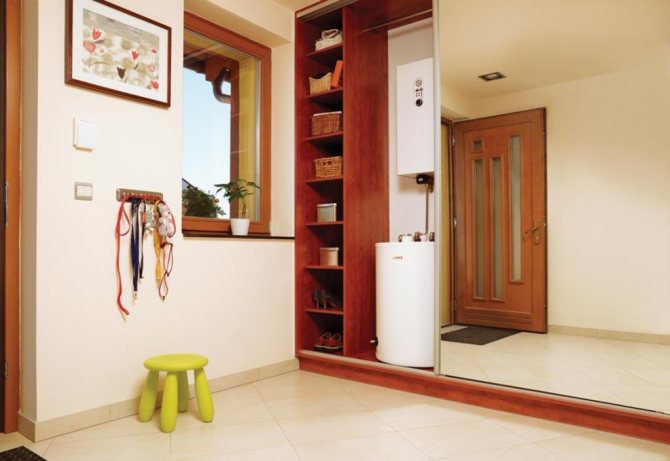

But I must also say about the disadvantages of autonomous gas heating in an apartment building. The probability of a gas explosion is, of course, minimal, but it still exists. Therefore, when installing the boiler indoors, you should also take care of a good ventilation system. Further. Regrettably, but the cost of gas for the population in cities is constantly increasing.
In addition, ventilation requires constant cleaning, since over time it becomes clogged with residues of combustion products - greasy soot. And if a coaxial chimney is also used, then an unpleasant odor can penetrate into the apartment through an open window. By the way, in order to install the latter in the facade of the building, the consent of the relevant authorities may also be required.
We recommend: Advantages of autonomous gas heating
How to make autonomous heating in an apartment: features of the gas system device
As a rule, such a heating system is installed in 4 stages:
- installation of a gas boiler;
- the old heating system is turned off and dismantled;
- heating pipes for the new system and radiators are installed;
- gas equipment is connected.
When everything has already been installed, a specialist from the gas service should be invited to start the boiler. Only he will be able to ensure that everything meets safety requirements. By the way, in the autonomous heating system in the apartment, water hammer is practically excluded, and therefore there is no need to worry about this. This means that you can save a little on the strength of structures: for example, install aluminum radiators and polypropylene pipes reinforced with foil.


However, when installing such a heating system, you should still adhere to a number of rules:
- radiators are connected to the circuit not in series, but in parallel;
- when inserting radiators, a diagonal scheme is used;
- a thermal head is made on the connection of each radiator;
- a Mayevsky crane is screwed into the upper plug of each battery;
- a valve is installed on the radiator supply;
- installation of all batteries is carried out strictly according to the level;
- on the spill, clips are used to compensate for the expansion of pipes when heated;
- before starting the system, be sure to pressure it.
In addition, in order for the autonomous heating of the apartment to work reliably and efficiently, it is advisable to include a circulation pump in the system.
YouTube responded with an error: Access Not Configured. YouTube Data API has not been used in project 268921522881 before or it is disabled. Enable it by visiting https://console.developers.google.com/apis/api/youtube.googleapis.com/overview?project=268921522881 then retry. If you enabled this API recently, wait a few minutes for the action to propagate to our systems and retry.
- Similar posts
- Which is better, autonomous heating or individual heating?
- How to make autonomous heating in a private house?
- How to make autonomous garage heating?
- Advantages of autonomous gas heating
- How much does autonomous heating cost?
- Types of autonomous heating of industrial premises
Autonomous heating system: varieties
Autonomous heating using gas is perhaps the most common in Russia today. After all, gas, by itself, is still a fairly cheap fuel. And the principle of operation of such systems is very simple, and it consists in the following. A gas boiler is mounted, to which heating radiators are connected with pipes. The boiler heats water or another heat carrier, which naturally or forcibly (using a circulation pump enters) the batteries, which give off heat to the rooms.
For the stable operation of the entire system, you will also need an expansion tank, shut-off valves, as well as temperature sensors and devices for its control. By the way, such heating can not only provide you with cheap heat, but also cheap hot water all year round. The savings on this resource can also be doubled. You just need to purchase a double-circuit gas boiler at once.
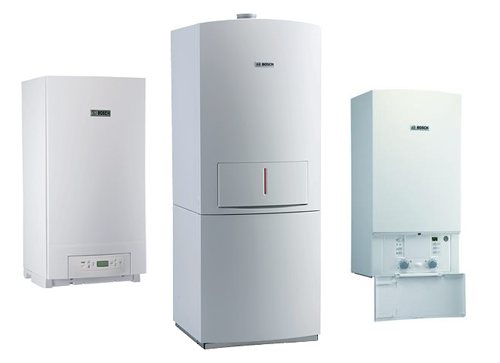

Double-circuit gas boilers
So, the advantages of such a system are:
- savings on heat in comparison with centralized heating several times;
- convenience - the boiler can be turned on and off when you need it, and the temperature in the system can be controlled;
- underfloor heating can be connected to such a system; and in general it is not difficult to combine it with other heating, for example, electric;
- you can use pipes and radiators, whatever you like; that is, get rid of old and bulky batteries, and put, for example, modern ones hidden under the panels.
However, there are also disadvantages of such autonomous heating:
- gas boilers must be checked and serviced annually;
- if a heating device breaks down, repairing it can cost you a pretty penny;
- you will have to monitor the heating system yourself - check if the pipes are leaking, if the radiators are warming up evenly, if there is no airing in them, the circulation pump is stable and working, and so on.
However, all this only sounds scary. With proper installation, which is carried out by professionals, when buying high-quality elements, you can usually not worry about the operation of such a system and check it only once a year - just before the start of the heating season. But then, what a savings every year on heat and hot water!
Heating with electricity, of course, is not as economical, but safer and even convenient, because you do not have to seek permission to install a gas boiler in your apartment. Therefore, in recent years, electric boilers have become more and more popular.
It is quite easy to understand why, because there are much more options for such heating. So, here it is generally possible not to "fence" entire pipe systems, but to install heating elements directly into the radiators. And there are also electric underfloor heating, special radiators with high efficiency, convectors, infrared radiation, and so on and so forth.
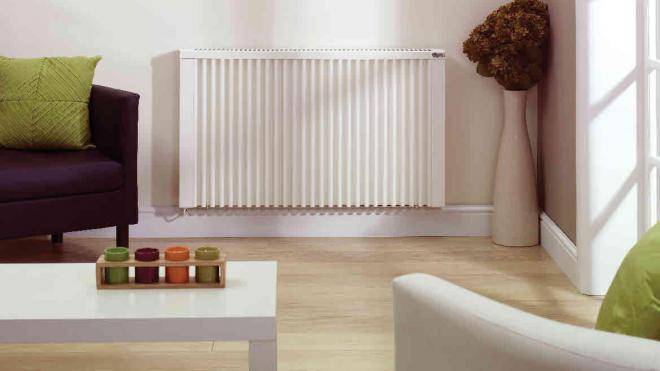

But not everyone understands that even such heating is more efficient than centralized, although in fact, here the savings are two-fold, with the use of modern devices and competent installation of the entire system. For comparison, we list below the advantages and disadvantages of autonomous heating with electricity. So the pros:
- a large selection of devices and their capabilities;
- it is not required to carry gas to the house or apartment, or to buy liquid or solid fuel, but there should already be light in any dwelling;
- the system can be powered, among other things, from alternative energy sources;
- significant savings compared to centralized heating;
- safety - you will not be poisoned by gas or combustion products of any other fuel.
Negative points:
when installing, it is important to use powerful wires, and your wiring must withstand them; that is, a separate line will be required; if the electricity is cut off, you will lose heat as well.
Piping layout
While heating engineers are discussing the optimal heating scheme for a central heating house, the issue of competent piping in the house is being raised. In modern multi-storey buildings, the heating wiring diagram can be implemented according to one of two possible patterns.
One pipe connection
The first template provides for a one-pipe connection with top or bottom wiring and is the most used option when equipping multi-storey buildings with heating devices. At the same time, the location of the return and supply is not strictly regulated and may vary depending on external conditions - the region in which the house is built, its layout, number of storeys and construction. The direct direction of movement of the coolant along the risers can also change. The option of movement of heated water in the direction from bottom to top or top to bottom is provided.
One-pipe connection is characterized by simple installation, affordable cost, reliability and long service life, but it also has a number of drawbacks. Among them, the loss of temperature of the coolant during movement along the contour and low efficiency indicators.
In practice, various devices can be used in order to compensate for the shortcomings in which a single-pipe heating scheme differs, a radiant system can become an effective solution to the problem. It is designed to use a manifold to help regulate temperature conditions.
Two-pipe connection
The two-pipe connection is the second version of the template. The two-pipe heating scheme of a five-story building (as an example) is devoid of the disadvantages described above, and differs in a completely different design than a one-pipe one. When implementing this scheme, the heated water from the radiator does not move to the next heating device in the circuit, but immediately enters the check valve and is sent to the boiler room for heating. Thus, it is possible to avoid the loss of temperature of the coolant circulating along the contour of a multi-storey building. The complexity of the connection, which is assumed by the two-pipe connection diagram of the heating battery in the apartment, makes the implementation of this type of heating a long and laborious process that requires large material and physical costs. Maintenance of the system is also not cheap, but the high cost is compensated by high-quality and uniform heating of the house on all floors. Among the advantages that a two-pipe circuit for connecting heating batteries gives, it is worth highlighting the possibility of installing a special device on each radiator in the circuit - a heat meter. It allows you to control the temperature of the coolant in the battery, and using it in the apartment, the owner will achieve significant results in terms of saving money on utility bills,after all, he will be able to independently regulate the heating if necessary.
Boiler accessories: what give the system
Thermostats- help to save on electricity, extend the service life of the equipment. Through it, the temperature inside the house is controlled, you just need to set the preferred heat level. It gives a signal when it is necessary to turn on and off the boiler. It regulates the heat supply itself, depending on the number of people in the house.
The operation of the thermostat is influenced by external factors:
- Intensity and frequency of airing;
- Direct sunlight from the window;
- Perceptible difference in outdoor temperature.
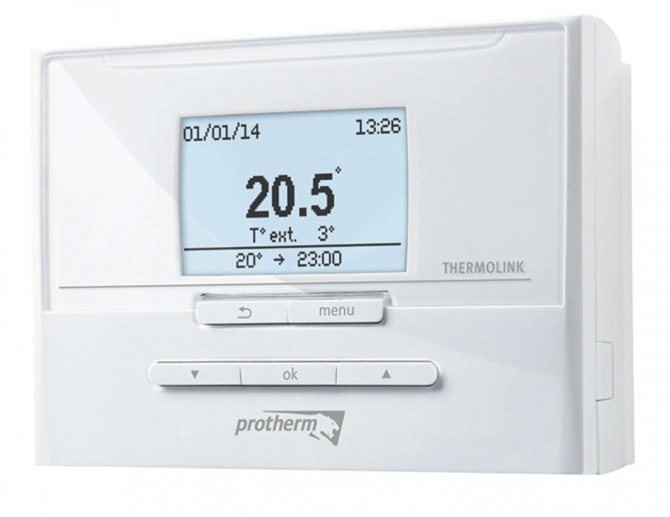

Heat regulator for heating boiler
Mount the device in a horizontal position. It is important to provide direct access to it, hide it from direct sunlight.
Stabilizers - these are electrical devices that operate from the network, pass current through themselves before being fed into the equipment. Energy is supplied to the working circuit with optimal voltage, even with external surges. This protects the boiler from the risk of breakdown due to sudden power surges.
There are two types:
- Electronic - they work with high efficiency, they can be fine-tuned, they act quickly;
- Electromechanical - precisely adjustable, do not influence overloads from the outside, operate in a wide range. Of the minuses: you adjust it in manual mode, they work slowly, not always suitable for a gas boiler.
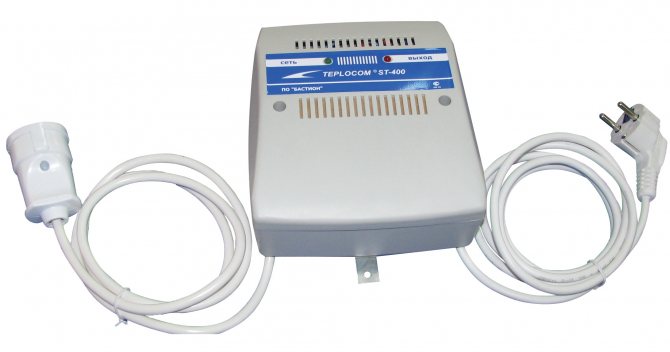

Voltage stabilizer for heating boiler
By what parameters to choose
- The power of the stabilizer must significantly exceed the power of the boiler. Heating boilers are usually purchased in the range of 200-350W. This means that the stabilizer must be taken at least 400W.
- The voltage of the stabilizer is also selected according to the needs of the boiler. For typical models, this is usually 160-270W.
Autonomous heating: pros and cons
The independence of the system is its main advantage. All advantages and disadvantages are consequences of autonomy.
- Heat supply mode - set according to the wishes and capabilities of the people living in the apartment, and not the capabilities of the communal farm of the apartment building. Extend the heating season or make it shorter, turn it off if the dwelling is left for a long time, or set it to a minimum heating level - any option is available and feasible.
- Heating regulation - the air temperature in the apartment is determined by its occupant. In most cases, an independent system allows you to install a thermostat on each radiator, which makes it possible to create an individual thermal regime.
- Savings - despite the hefty initial costs - if we are not talking about an electric boiler, the cost of heating the apartment and the maintenance of the system itself are significantly reduced compared to paying for centralized heating services.
- In the case of installing a double-circuit water heating boiler, it is possible to independently supply the dwelling with hot water all year round.
The disadvantages of autonomous heating are associated with the fact of its installation and the need to independently take care of its normal functioning.
- Installation - all elements of the system are purchased independently, installed by their own hands or with the help of specialists. The initial expense is quite significant. The photo shows a working moment.
- The installation of a heating system is associated with the partial destruction of wall partitions, the integrity of the floors, and so on. Most likely, after this, at least cosmetic repairs will have to be carried out in the home.
- Instrument repair and maintenance - carried out by representatives of service centers on various conditions. But in any case, paying for them is only a problem for the owner. Deciding whether this is a disadvantage or an advantage is sometimes difficult.
- Installation of autonomous heating requires a permit. Of the above, this circumstance is perhaps the most difficult and tedious, judging by the reviews.However, these requirements are not only a product of bureaucratic activity, but also help prevent the installation of illegal uncertified equipment, which poses a serious danger to all residents of an apartment building.
The convenience and efficiency of any version of an independent system so much exceeds the costs of effort, time and money for its installation that there can be no two opinions: if the installation is fundamentally possible, then it is worth implementing it without putting it on the back burner.
Requirements
It is necessary that the unit has all the appropriate clips:
- Flame presence control.
- Traction and temperature monitoring.
- In the absence of fire, the shut-off valve must operate.
Therefore, buying boilers is better than those manufacturers who have been on the market for more than one year. Also, the annual maintenance should be carried out by the relevant authorities, and this cannot be denied. Today, gas distribution stations not only carry out the gas supply procedure, but also offer high-quality boilers at affordable prices. In this case, they are already fully responsible for the entire process of the device.
Independent heating what is independence
The main task that residents of a city apartment, who have expressed a desire to become independent from centralized heating, may face, is obtaining permission. Without official documents permitting to disconnect from central heating and a finished project for future autonomous heating in an apartment, it is impossible to dismantle the equipment.
Important! Unauthorized actions to turn off and dismantle central heating elements in the premises of an apartment building can be regarded as an administrative offense. If such facts are revealed, the apartment owner is forced not only to pay a fine, but also to restore the dismantled equipment at his own expense.
In the process of solving organizational issues, one should not leave the development of the project for later. In other words, if you decide to equip decentralized heating in your apartment, you will have to decide in advance on which type of autonomous heating to give preference to.
The concept of "independent" in relation to a city apartment looks rather arbitrary. Unlike a private house, where the owner has great technological capabilities, a city apartment has limited resources. In private households, you can install autonomous heating of almost any kind. With the desire of the homeowner and certain finances, you can really achieve complete independence from centralized energy suppliers.
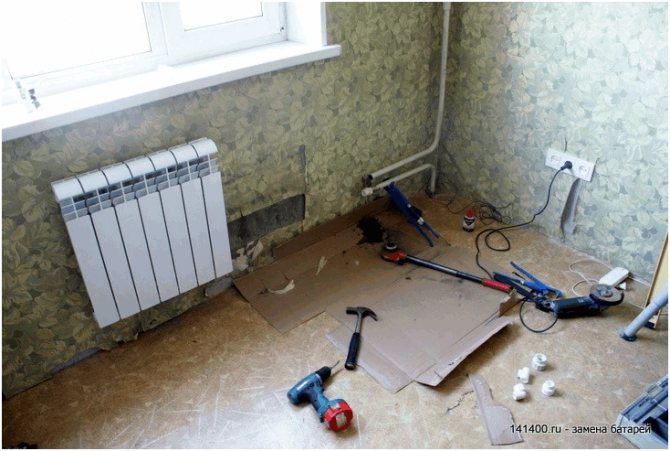

The main advantages of independent heating systems are as follows:
- the ability to independently adjust the intensity of heating of residential premises;
- quick start and quick shutdown of autonomous heating systems;
- a real opportunity to achieve savings on energy costs;
- maintaining the optimum permissible temperature in the apartment at any time of the year.
The presence of in-house communications, the layout of apartments and strict technical standards do not allow apartment owners in an apartment building to use stove and air heating, and other alternative heating options. In this case, you have to be content with gas or electricity. Any interruptions in power supply or gas supply will nullify all your independence. The only thing that can be done is to equip autonomous home heating, using one of the main sources, and keep the second as a backup, fallback option.
Note: when submitting documents for disconnection from central heating, you will have to attach an alternative heating project for your apartment.The choice of energy sources is not great, the project can be designed for the installation of gas heating equipment or electric. Any other options for independent heating will not be approved and will be rejected.






